| Schedule | Lectures | Seminars | Tests | Glossary | Cases | Index | Review | Search | Feedback | |
| Schedule | Lectures | Seminars | Tests | Glossary | Cases | Index | Review | Search | Feedback | |
With regard to female contributions, a comprehensive history includes collecting data with regard to prior illnesses, surgeries, infections (including sexually transmitted diseases), allergies, drug use (prescription and recreational), rubella, or on utero diethylstilbestrol exposure. We like to identify personal habits such as vigorous exercise or smoking and practices before and after intercourse (e.g., CONTRACEPTION / SEXUAL DIFFERENTIATION or lubricant use or douching). A physical exam includes a collection for a Pap smear and evaluation for sexually transmitted diseases.
 Click here for a larger view. |
Causes of Female Infertility.
Ovulatory dysfunction and mechanical factors are the major causes of female infertility.
Credits: Serono Laboratories |
With regard to identified causes of female infertility, approximately 30% to 50% of patients visiting an infertility clinic have tubal factors such as adhesions or endometriosis which may play a role in their infertility. Cervical factors such as hostile cervical mucus or previous cone biopsy that affects cervical mucus account for less than 10% of causes of female infertility. Approximately 40% of women with infertility fall into the ovulatory dysfunction category.
One of the most critical factors with regard to an infertility evaluation of a woman is evaluation of her menstrual cycle. While not a high-tech procedure, the basal body temperature chart certainly provides a significant amount of information with regard to a woman's ovulatory status. This is done by having the patient measure her temperature using a digital thermometer before arising in the morning. Normal ovulation triggers a .4 to 1 degree Fahrenheit increase in body temperature. While ovulation detector kits are a helpful adjuvant of timing of intercourse around ovulation, they do not give information with regard to the luteal phase. An elevated temperature for approximately ten days identifies a normal luteal phase length.
 Click here for a larger view. |
Basal Body Temperature Chart.
The basal body temperature is an inexpensive diagnostic tool to determine a woman's ovulatory status.
Credits: Serono Laboratories |
While laboratory values are not always critical in the initial infertility evaluation, some tests are of help in particular situations. This screen demonstrates specific situations for which laboratory values are helpful in confirming a diagnosis. An additional assay that is often obtained on infertility patients is a thyroid-stimulating hormone. Mild abnormalities of thyroid function can affect the ovulatory pattern.
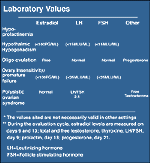 Click here for a larger view. |
Characteristic laboratory values.
The laboratory abnormalities in various conditions.
Credits: Serono Laboratories |
A hysterosalpingogram is performed after the cessation of menses and before ovulation; it allows visualization of the intrauterine cavity. This test is particularly helpful in detecting uterine abnormalities such as a bicornuate uterus or septate uterus.
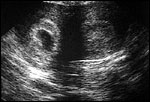 Click here for a larger view. |
Bicornuate Uterus.
Ultrasound showing the two horns of a bicornuate uterus.
Credits: Roya Sohaey, M.D. |
Tubal patency is also demonstrated by this examination. While tubal patency may be present, this does not exclude adhesions in the pelvic cavity which could inhibit the ovum from reaching the fallopian tube. Another procedure performed usually late in the evaluation of an infertile couple is laparoscopy.
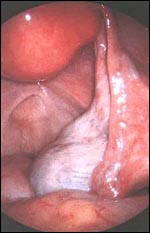 Click here for a larger view. |
Laparoscopic evaluation of the pelvis.
Endometrial implants are seen in this view.
Credits: C. Matthew Peterson, M.D. |
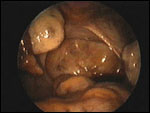 Play Video |
Laparoscopy and chromohydrotubation. (VIDEO)
Bilateral patency of the fallopian tubes is
demonstrated.
Credits: C. Matthew Peterson, M.D. |
Here you see endometriosis on the peritoneal surface in the pelvic cavity :
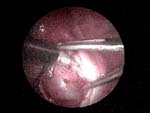 Play video. |
Laparoscopy demonstrating an endometrioma. (VIDEO)
Credits: C. Matthew Peterson, M.D. |
While moderate or severe endometriosis certainly may be associated with infertility, minimal or mild endometriosis by American Society for Reproductive Medicine (ASRM) scoring has the same pregnancy rates, treated or untreated. Surgical and medical therapies are available for the treatment of endometriosis:
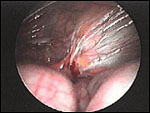 Play video |
Endometriosis-scarring. (VIDEO)
Endometriosis may cause scarring and puckering peritoneal surfaces and resultant anatomic distortions which may also result in infertility.
Credits: C. Matthew Peterson, M.D. |
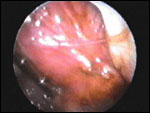 Play video |
Endometriosis- pain. (VIDEO)
Endometriosis on the posterior surface of the uterus near the uterosacral ligaments may result in significant pelvic pain. Inflammation and early adhesion formation is demonstrated.
Credits: C. Matthew Peterson, M.D. |
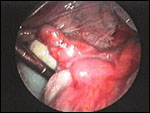 Play video |
Endometriosis with dense adhesion formation. (VIDEO)
Endometriosis may result in dense adhesions which
bind surfaces together as demonstrated here with the right ovary and posterior surface of the broad ligament. Over 1/3 of the potential ovulating surface of the ovary is effectively blocked from
free release of oocytes from this area. This may result in compromised fecundability.
Credits: C. Matthew Peterson, M.D. |
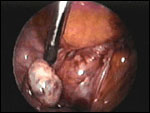 Play video |
Rectosigmoid adhesion to lower uterine segment. (VIDEO)
Endometriosis affecting the uterosacral ligament
area may result in adhesions of the rectosigmoid to the affected area. This patient presented with
severe dyschezia, dyspareunia, and dysmenorrhea.
Credits: C. Matthew Peterson, M.D. |
Tubal adhesions and scar tissue from endometriosis and other pelvic problems
(STD, peritonitis, appendicitis) may also be treated surgically:
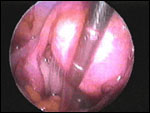 Play video |
Adhesions as a result of Chlamydia trachomatis. (VIDEO)
Multiple adhesions are found after this patient had an unrecognized pelvic infection caused by
Chlamydia trachomatis.
Credits: C. Matthew Peterson, M.D. |